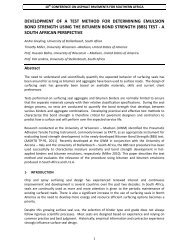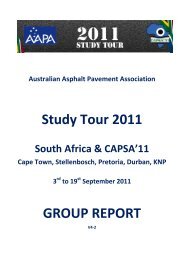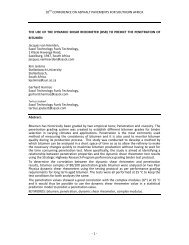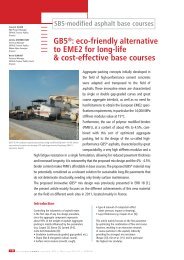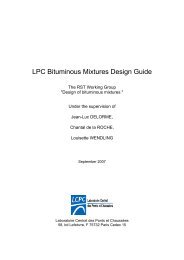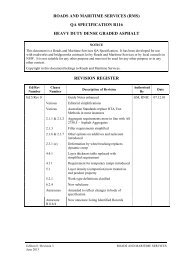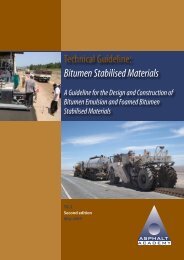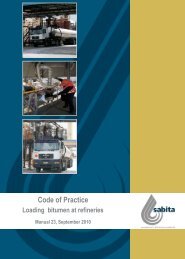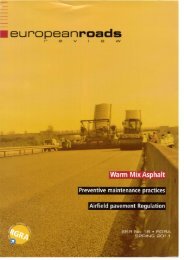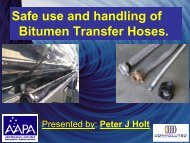• Protect glass that is subject <strong>to</strong> high pressure or vacuum. Wrapp<strong>in</strong>gglass vessels with cloth tape will m<strong>in</strong>imise <strong>the</strong> possibility <strong>of</strong> projectiles;• Glass is weakened by everyday stresses such as heat<strong>in</strong>g andbump<strong>in</strong>g. Handle used glassware with extra care;• Discard or repair all damaged glassware, as chipped, cracked orstar-cracked vessels cannot handle <strong>the</strong> normal stresses.When <strong>handl<strong>in</strong>g</strong> glass rods or tubes:• fire polish <strong>the</strong> ends;• lubricate with water or glycer<strong>in</strong>e when <strong>in</strong>sert<strong>in</strong>g through s<strong>to</strong>pper;• ensure s<strong>to</strong>pper holes are properly sized, and not <strong>to</strong>o small;• <strong>in</strong>sert s<strong>to</strong>ppers carefully, with a slight twist<strong>in</strong>g motion, keep<strong>in</strong>g handsclose <strong>to</strong>ge<strong>the</strong>r; and• use gloves or a cloth <strong>to</strong>wel <strong>to</strong> protect your hands.9.5 Safe labora<strong>to</strong>ry conduct and housekeep<strong>in</strong>gTo m<strong>in</strong>imise <strong>the</strong> potential for eat<strong>in</strong>g/dr<strong>in</strong>k<strong>in</strong>g hazardous materials, <strong>the</strong>follow<strong>in</strong>g procedures are recommended <strong>in</strong> all labora<strong>to</strong>ries. No eat<strong>in</strong>g,dr<strong>in</strong>k<strong>in</strong>g, smok<strong>in</strong>g, gum chew<strong>in</strong>g, or application <strong>of</strong> cosmetics should takeplace <strong>in</strong> areas where chemicals are s<strong>to</strong>red or used.• Wash hands and face after work<strong>in</strong>g with or around chemicals andbefore eat<strong>in</strong>g, dr<strong>in</strong>k<strong>in</strong>g, smok<strong>in</strong>g, us<strong>in</strong>g <strong>the</strong> restroom, apply<strong>in</strong>gcosmetics, or leav<strong>in</strong>g <strong>the</strong> facility;• Do not s<strong>to</strong>re, handle, or prepare food or beverages <strong>in</strong> refrigera<strong>to</strong>rs,glassware, utensils, microwaves, ovens, cab<strong>in</strong>ets, s<strong>in</strong>ks, counter<strong>to</strong>ps,tables, or o<strong>the</strong>r locations which are also used for labora<strong>to</strong>ryoperations. Food and dr<strong>in</strong>k is permitted only <strong>in</strong> designated eat<strong>in</strong>g,preparation, and food s<strong>to</strong>rage locations with<strong>in</strong> <strong>the</strong> labora<strong>to</strong>ry;• Do not enter designated eat<strong>in</strong>g, preparation and food s<strong>to</strong>rage areaswear<strong>in</strong>g contam<strong>in</strong>ated cloth<strong>in</strong>g or with contam<strong>in</strong>ated labora<strong>to</strong>ry <strong>to</strong>olsor equipment. If <strong>in</strong> doubt, remove or clean equipment and cloth<strong>in</strong>gbefore br<strong>in</strong>g<strong>in</strong>g it <strong>in</strong><strong>to</strong> <strong>the</strong>se areas;• Do not leave cigarettes ly<strong>in</strong>g <strong>in</strong> a labora<strong>to</strong>ry or near fumes which canbe absorbed by <strong>the</strong> cigarettes;• To m<strong>in</strong>imise <strong>the</strong> hazard <strong>of</strong> residual chemicals, always clean <strong>the</strong> workarea after complet<strong>in</strong>g test procedures or labora<strong>to</strong>ry work. Wipe up anyspills or waste material and dispose <strong>of</strong> properly. Clean <strong>to</strong>ols and64
conta<strong>in</strong>ers that may be contam<strong>in</strong>ated before putt<strong>in</strong>g <strong>the</strong>m away.Clean any protective equipment that may have been contam<strong>in</strong>atedand s<strong>to</strong>re properly. After protective equipment has been removed,check personal cloth<strong>in</strong>g for contam<strong>in</strong>ation. Remove or neutralisecontam<strong>in</strong>ation or contam<strong>in</strong>ated cloth<strong>in</strong>g before leav<strong>in</strong>g <strong>the</strong> labora<strong>to</strong>ryor go<strong>in</strong>g home. Always wash face and hands before leav<strong>in</strong>g;• Avoid practical jokes or o<strong>the</strong>r behavior that might confuse, startle ordistract ano<strong>the</strong>r worker. Never use labora<strong>to</strong>ry chemicals, materials, orequipment for practical jokes or horseplay;• Do not use mouth suction for pipettes or start<strong>in</strong>g a siphon;• To m<strong>in</strong>imise <strong>the</strong> hazards <strong>of</strong> entanglement or chemical contam<strong>in</strong>ation<strong>the</strong> follow<strong>in</strong>g personal apparel rules are recommended: Conf<strong>in</strong>e long hair, necklaces, neckties, and o<strong>the</strong>r loose cloth<strong>in</strong>gthat could get caught <strong>in</strong> mov<strong>in</strong>g equipment or be contam<strong>in</strong>atedwith chemicals; Remove jewelry, r<strong>in</strong>gs, earr<strong>in</strong>gs, watches, and o<strong>the</strong>r personalitems that will <strong>in</strong>terfere with <strong>the</strong> use <strong>of</strong> protective equipment orcould get caught <strong>in</strong> equipment; Appropriate shoes should be worn at all times <strong>in</strong> <strong>the</strong> chemical andmaterials <strong>handl<strong>in</strong>g</strong> and s<strong>to</strong>rage areas <strong>of</strong> <strong>the</strong> labora<strong>to</strong>ry. Sandals,flip- flops, or open <strong>to</strong>ed shoes are not allowed;• Personal housekeep<strong>in</strong>g: Keep <strong>the</strong> work area clean and uncluttered; Keep chemicals and equipment properly labeled and s<strong>to</strong>red; Clean <strong>the</strong> area on completion <strong>of</strong> an operation or at <strong>the</strong> end <strong>of</strong> <strong>the</strong>day.9.6 Equipment <strong>safe</strong>tyWhenever labora<strong>to</strong>ry equipment is purchased, preference should be given<strong>to</strong> equipment that:• limits contact between <strong>the</strong> opera<strong>to</strong>r and hazardous material, andmechanical and electrical energy;• is corrosion-resistant, easy <strong>to</strong> decontam<strong>in</strong>ate and impermeable <strong>to</strong>liquids;• has no sharp edges or burrs.65



